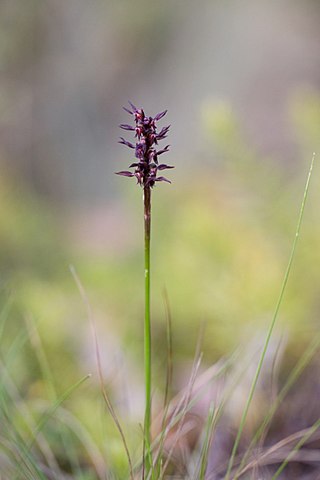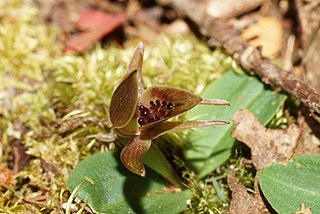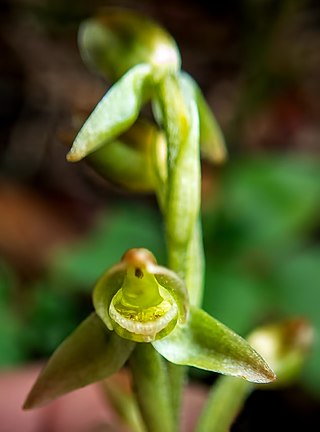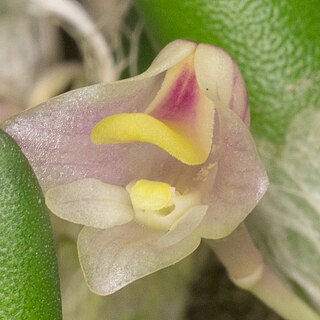
Cheirostylis, commonly known as fleshy jewel orchids or velvet orchids, is a genus of about sixty species of flowering plants in the orchid family Orchidaceae. Plants in this genus are terrestrial herbs with a caterpillar-like rhizome and a loose rosette of leaves. Small, white, hairy flowers develop as the leaves wither. They are found in tropical Africa, southern Asia, Southeast Asia, Malesia, New Guinea and Australia.
Zeuxine oblonga , commonly known as the common jewel orchid is a species of orchid that is endemic to northern Australia. It has up to seven narrow egg-shaped leaves and up to thirty small green and white flowers crowded along a fleshy, hairy flowering stem. It mainly grows in wet forest and rainforest.

Pterostylis squamata, commonly known as the southern rustyhood or ruddyhood, is a plant in the orchid family Orchidaceae and is endemic to south-eastern Australia. Flowering plants have up to ten translucent green flowers with reddish-brown markings and a hairy, insect-like labellum. Non-flowering plants have a rosette of four to eight egg-shaped leaves. This species is very similar to Pterostylis rufa which has a narrower labellum and other minor differences.

Pterostylis aneba is a species of orchid endemic to south-eastern Australia. It is a recently described and poorly-known greenhood similar to Pterostylis alpina and P. monticola. It has a rosette of fleshy leaves at the base of the plant and a single green and white flower. It grows in alpine and sub-alpine habitats.

Pterostylis hamata, commonly known as the southern hooked rustyhood, is a plant in the orchid family Orchidaceae and is endemic to eastern Australia. It has a rosette of leaves and between two and twelve transparent flowers with green and brown markings, a thick, brown, insect-like labellum and dished lateral sepals.

Pterostylis calceolus, commonly known as the Bungonia rustyhood, is a plant in the orchid family Orchidaceae and is endemic to New South Wales. It has a rosette of overlapping leaves and between two and seven reddish-brown flowers with transparent "windows" and a fleshy brown, insect-like labellum. It is only known from near Bungonia.
Pterostylis erythroconcha, commonly known as the red shell orchid, is a species of orchid endemic to South Australia. As with similar orchids, the flowering plants differ from those which are not flowering. The non-flowering plants have a rosette of leaves but the flowering plants have a single flower with leaves on the flowering spike. This greenhood has a white and green flower with reddish brown markings and a long, fleshy, curved labellum.

Pterostylis gibbosa, commonly known as the Illawarra rustyhood, or Illawarra greenhood, is a plant in the orchid family Orchidaceae and is endemic to New South Wales. It has a rosette of leaves at its base and up to nine bright green flowers with translucent "windows", relatively wide lateral sepals with short-pointed tips and a dark, fleshy, insect-like labellum.

Pterostylis prasina, commonly known as the mallee leafy greenhood, is a plant in the orchid family Orchidaceae and is endemic to southern continental Australia. Non-flowering have a rosette of leaves on a short stalk, but flowering plants lack the rosette and have up to eight pale green and translucent green flowers with darker green lines. The flowers have a pale green labellum with a darker central line. It is a common and widespread greenhood in parts of Victoria and South Australia.
Pterostylis saxicola, commonly known as the Sydney plains rustyhood, or Sydney plains greenhood, is a plant in the orchid family Orchidaceae and is endemic to New South Wales. It has a rosette of leaves at its base and up to ten reddish-brown flowers with translucent "windows", relatively wide lateral sepals with short-pointed tips and a dark brown, fleshy, insect-like labellum.
Pterostylis uliginosa, commonly known as the marsh greenhood, is a species of orchid endemic to south-eastern Australia. As with similar orchids, flowering plants differ from non-flowering. The non-flowering plants have a rosette of leaves. The flowering plants lack a rosette at the base but have up to three rosettes on lateral growths and up to seven small green and white flowers. This species only grows in wet places, usually where there is free water. There are usually only two or three flowers per plant, and only one or two open at a time.

Genoplesium arrectum, commonly known as the erect midge orchid and as Corunastylis arrecta in Australia, is a small terrestrial orchid endemic to south-eastern Australia. It has a single thin leaf fused to the flowering stem and up to twenty small, dark purple flowers. It grows in a montane and subalpine grassland and forest in Victoria and the Australian Capital Territory.

Microtis orbicularis, commonly known as the dark mignonette orchid, is a species of orchid endemic to southern Australia. It has a single thin, more or less hollow, onion-like leaf and up to fifty small yellowish-green and red flowers. The plants grow in winter-wet areas, often in shallow water and unlike the similar M. cupularis do not turn black as they dry.

Chiloglottis grammata, commonly known as the small bird orchid, is a species of orchid endemic to Tasmania. It has two broad leaves and a single greenish purple to purple flower with short, shiny greenish to reddish or black calli and low ridges resembling writing, covering most of the upper surface of the labellum. It is widespread and common in high rainfall mountainous areas.

Eriochilus tenuis, commonly known as the slender bunny orchid, is a plant in the orchid family Orchidaceae and is endemic to Western Australia. It has a single egg-shaped leaf lying flat on the ground and one or two small pink or pink and white flowers. A common species, it grows in dense, shrubby forest and in winter-wet swamps.

Anoectochilus yatesiae, commonly known as the marbled jewel orchid, is a species of orchid that is endemic to northern Queensland. It has up to six dark green leaves with a network of silvery veins and up to four hairy brownish and white flowers.
Cheirostylis ovata, commonly known as the banded fleshy jewel orchid, is a species of orchid that is endemic Queensland where it grows in rainforest and moist woodland. It has between three and seven egg-shaped leaves and up to six small white flowers with two lobes on the end of the labellum.

Goodyera umbrosa, commonly known as the native jade orchid or green jewel orchid, is a species of orchid that is endemic to northern Queensland where it grows in highland rainforest. It has between four and eight large, egg-shaped leaves and up to ten small pale green or pinkish flowers with the dorsal sepal and petals forming a hood over the column.

Dendrobium lichenastrum, commonly known as the common button orchid, is a species of epiphytic or lithophytic orchid endemic to far north Queensland. It has a creeping, branching rhizome surrounded by papery bracts, small egg-shaped to round, fleshy, dark green leaves and a single white, cream-coloured or pink flower with red stripes and an orange labellum.

Sarcochilus serrulatus, commonly known as the banded butterfly orchid, is an epiphytic orchid endemic to tropical North Queensland. It has up to six crowded leaves with finely toothed and wavy edges and up to ten reddish brown flowers with a white, yellow-banded labellum.














